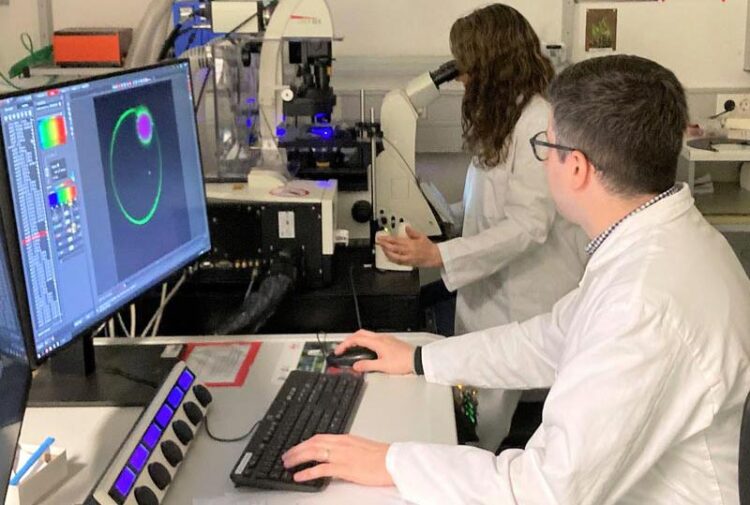Shaping Cells with Light

Mina Aleksanyan and Agustín Mangiarotti recording the membrane response at the confocal microscope
(c) MPIKG
With the Flick of a Switch…
Imagine switching on a light and being able to understand and control the inner dynamics of a cell. This is what the Dimova group has achieved: by shining lights of different colors on replicates of cells, they altered the interactions between cellular elements. Controlling these complex interactions enables us to deliver specific drugs directly into the cells. And with the flick of a switch, we could adjust or even reverse this delivery, potentially revolutionizing the treatment of cells in a smart, accurate and non-invasive way.
Cells are the building blocks of our body and are organized into smaller components, each with a specialized function. Most of these components are enveloped by a protective membrane made of fats. All, with the exception of the biomolecular condensates. These tiny, dynamic droplets prepare the cell for rapid stress response by gathering and organizing repair molecules (among other functions). Rumiana Dimova and her team at the Max Planck Institute of Colloids and Interfaces study the many and intricate ways in which condensates interact with membranes, and how they affect each other’s shape and structure. In their latest work, the researchers have focused on the process of endocytosis. This is how a cell wraps its outer membrane around nutrients or pathogens to ‘eat’ them.
The researchers designed their own lab-made, simplified versions of cells – called giant vesicles – to simulate the cellular processes and analyze them under the microscope. They introduced fats that react to light (“photoswitchable lipids”). Dimova and her team observed how the membranes behaved when exposed to light of different colors: they changed their size and triggered various interactions with the condensates.
“When we shine ultraviolet light on a membrane, it grows and ‘swallows’ the condensates,“ – explains Agustín Mangiarotti. “And we can also reverse the process by switching to blue light,” adds Mina Aleksanyan, “so that the membrane shrinks, expelling the condensate.” This is clearly visible in the video captured using a fluorescence microscope.
The therapeutic potential of this research is immense. The combined use of giant vesicles and light could represent a non-invasive medical treatment to control cellular dynamics.
Here is why. Light is inexpensive and sustainable. And because giant vesicles are synthetic (made in a lab), scientists can use them to probe several dynamics without resorting to culture cells from living organisms. And there is more. Giant vesicles are biomimetic – constructed from molecules found in the human body, such as fats and proteins. They are like tiny capsules that can carry drugs and then fuse organically with cells. “Now we know that by modulating light we can control how vesicles shape the inner environment of a cell, which could help treat cellular disorders. It’s like being able to sculpt a cell from the inside by flicking a light switch,” concludes Dimova.
Wissenschaftliche Ansprechpartner:
Dr. Rumiana Dimova
Max Planck Institute of Colloids and Interfaces
Am Mühlenberg 1
14476 Potsdam
Germany
rumiana.dimova@mpikg.mpg.de
+49 331 567-9615
Originalpublikation:
A. Mangiarotti, M. Aleksanyan, M.Siri, T. Sun, R. Lipowsky, R.Dimova, Photoswitchable Endocytosis of Biomolecular Condensates in Giant Vesicles, Advanced Science (2024)
https://doi.org/10.1002/advs.202309864
Media Contact
All latest news from the category: Life Sciences and Chemistry
Articles and reports from the Life Sciences and chemistry area deal with applied and basic research into modern biology, chemistry and human medicine.
Valuable information can be found on a range of life sciences fields including bacteriology, biochemistry, bionics, bioinformatics, biophysics, biotechnology, genetics, geobotany, human biology, marine biology, microbiology, molecular biology, cellular biology, zoology, bioinorganic chemistry, microchemistry and environmental chemistry.
Newest articles

First-of-its-kind study uses remote sensing to monitor plastic debris in rivers and lakes
Remote sensing creates a cost-effective solution to monitoring plastic pollution. A first-of-its-kind study from researchers at the University of Minnesota Twin Cities shows how remote sensing can help monitor and…

Laser-based artificial neuron mimics nerve cell functions at lightning speed
With a processing speed a billion times faster than nature, chip-based laser neuron could help advance AI tasks such as pattern recognition and sequence prediction. Researchers have developed a laser-based…

Optimising the processing of plastic waste
Just one look in the yellow bin reveals a colourful jumble of different types of plastic. However, the purer and more uniform plastic waste is, the easier it is to…



